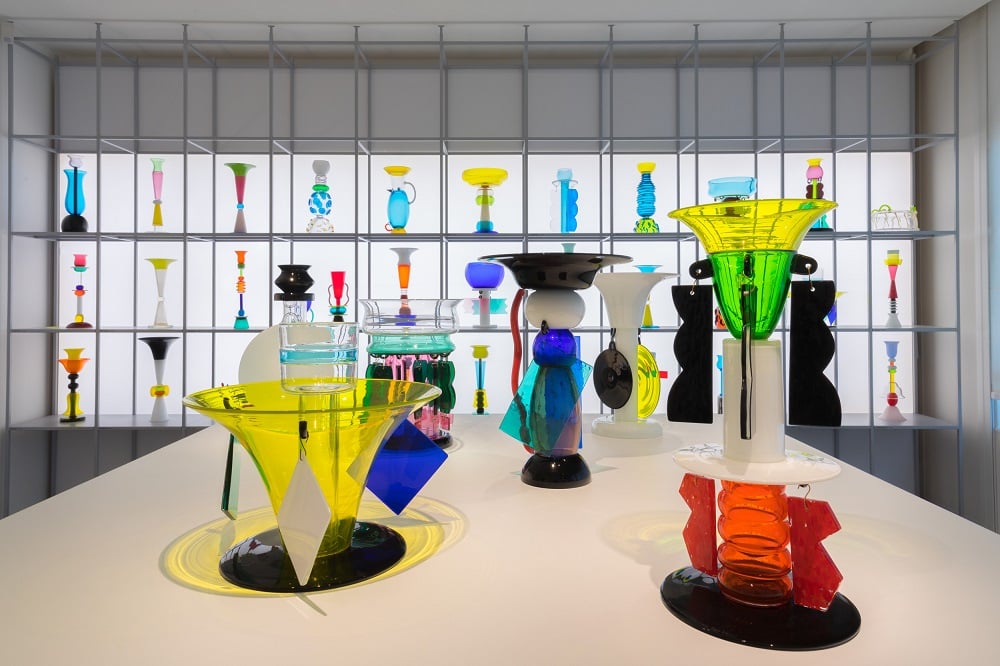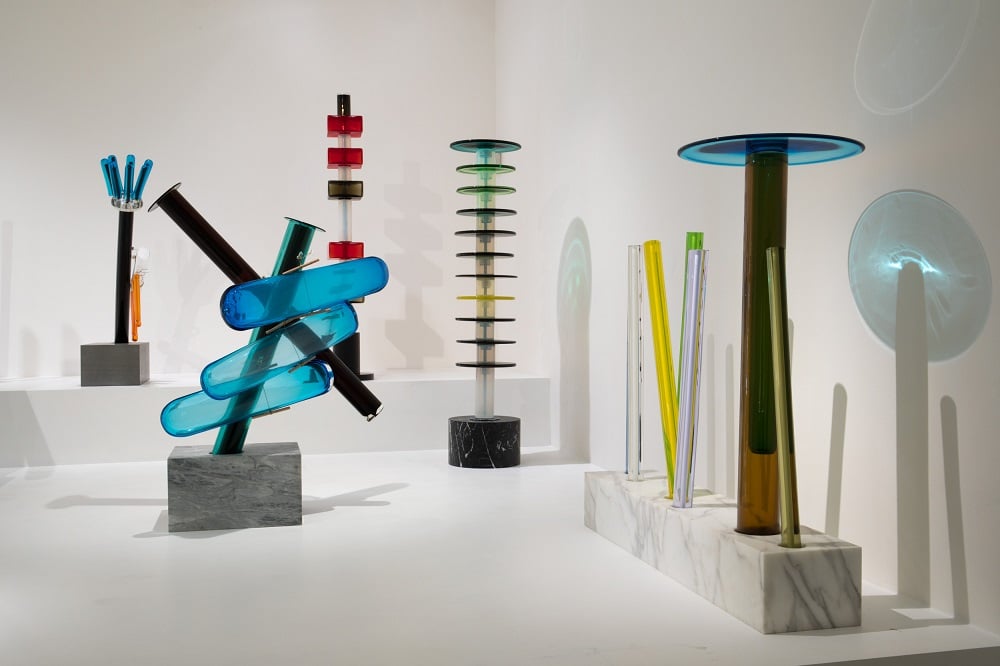Art World
The Fantastical Glass Works of Ettore Sottsass Get Their Due in Venice
Discover the radical designer's glass objects ahead of his major survey at the Met Breuer.

Discover the radical designer's glass objects ahead of his major survey at the Met Breuer.

Hili Perlson

Last week, on the island of St. Giorgio Maggiore in Venice, a group of curators, scholars, and design experts convened in the halls of the former Benedictine monastery that now houses the Giorgio Cini Foundation to discuss the work of Italian architect and designer Ettore Sottsass.
The year 2017 marks the 100th anniversary of Sottsass’s birth, and the Cini Foundation is dedicating a show to the 20-century maverick’s works in glass at the adjacent exhibition space Le Stanze del Vetro, which the foundation launched in 2012 together with the Swiss nonprofit Pentagram Stiftung. The space is committed to highlighting the importance of glass as an artistic medium, especially in its connection to the history of Venice. (Pentagram Stiftung’s founder, David Landau, is a highly specialized collector of Venini glass works; in 2014, he and his wife donated Venini pieces by Carlo Scarpa to the Metropolitan Museum.)
Curated by Luca Massimo Barbero, director of the Cini Foundation’s art history department, the exhibition features over 220 works Sottsass produced from 1947 until his death, in 2007, often in collaboration with industrial companies. Many pieces have never been exhibited before, such as the 22 glass sculptures Sottsass designed for the foyer of the “Millennium House” in Doha, a vanity project by the Sheik of Qatar that was never realized and also included a swimming pool design commissioned from David Hockney.

Installation view of pieces created for the Millennium House on view for the first time at “Ettore Sottsass: il vetro.” Photo by Enrico Fiorese ©Ettore Sottsass by SIAE 2017.
Rather than following a chronological exploration, the show begins with works from the 1980s, belonging to Sottsass’s Memphis series—a movement that, for better or worse, most viewers will associate his name with, although his work encompasses so much more than the eccentric, Formica-laminated design objects now hunted at auctions by die-hard fans.
The Memphis room makes for a dazzling opener: On a plinth in the center, some eight vases in vivid colors bear dangling decorative accoutrements reminiscent of the whimsical yet elegant fashion sense of a prototypical eccentric art patron. Backlit shelves checker a wall facing the plinth, each holding a piece from the 1986 series that further avers Sottsass’s departure from functionality in his work with glass. (The excellent exhibition design was done by Annabelle Selldorf.)
Importantly, works from the Memphis series also mark Sottsass’s unorthodox experimentation with the medium where, for the first time in 1986, he introduced the use of chemical gluing techniques, breaking with the centuries-old Murano glass tradition of joint heating. The audacity of this technique was a topic of heated discussion at the conference, revealing how contested it still is some four decades after the fact.
Dazzling displays in the subsequent rooms feature pieces produced with different craftsmen radically testing the boundaries of the medium, among other things through combinations with materials such as marble and clay. The glass works gradually become more geometrically coherent, and are imbued with an element of the spiritual and otherworldly—ironically at first, such as in the piece Asparagi sacri (sacred asparagus), created in 1994 for Galerie Bruno Bischofberger, and then earnestly, as in the 2004 series Kachinas, inspired by the Native American ceremonial dolls.

Installation view of the Kachinas series and drawings in the show “Ettore Sottsass: il vetro. Photo by Enrico Fiorese ©Ettore Sottsass by SIAE 2017
It is this allusion to the spiritual faculties of objects, so central to Sottsass’s work, that informed his interest in glass. “Glass is an incredible medium, at once mysterious, transparent, and fragile,” he is quoted in the exhibition’s catalog. “Glass, like ceramics, has a very peculiar characteristic: One doesn’t really know what goes into the furnace. Then all of a sudden a pure object breaks out, burnt by fire, an object of sheer purity and physical intangibility. It is like a vision,” he said in one of his final interviews.
In his work with diverse mediums and disciplines, from product design—like his iconic Valentine portable typewriter for Olivetti (1969)—to his Offerings to Shiva plates from the Ceramics of Darkness series, created while he was recovering from a life-threatening illness (and currently on view at the Olivetti Showroom in Venice, too), Sottsass was interested in the objects’ suitability for mass production, while at the same time imbuing them with a human element, a “soul,” as Christian Larsen, the Metropolitan Museum’s new associate curator described in his talk at the conference, and “the possibility of design to transfer magic from older, ritualistic objects by replicating their appearance.”
The first speaker of the day, Larsen was the only curator on the podium that has not worked directly with Sottsass. Presenters included Centre Pompidou’s Marie-Laure Jousset, who curated Sottsass’s 1994 retrospective in Paris, and Michele De Lucchi, who was a member of Memphis, among other speakers who knew the designer personally. However, it is Larsen’s upcoming survey of Sottsass’s work at the Met Breuer (and his first as curator at the museum) that could have a significant impact on the way the designer’s legacy will be understood by an American audience.
The exhibition, which is titled “Ettore Sottsass, Design Radical” and opens on July 20, came about after a different exhibition had been cancelled last minute, Larsen divulged as he went through a Power Point presentation of his soon-to-open show. That left him with only nine months to put it together, and no time for arranging loans. But what the Met Breuer survey might lack in terms of major pieces from the collections of European institutions, will be made up for in scholarly approach to contextualizing Sottsass’s importance and his impact on 20-century ideas, by setting his work in dialogue with pieces from the Met’s massive collection. His notions of transferring magical properties from ancient artifacts is certainly something the Met is uniquely positioned to illustrate.
“Ettore Sottsass: The Glass” is on view at Le Stanze del Vetro in Venice until July 30, 2017.
“Ettore Sottsass, Design Radical” will be on view the Met Breuer in New York from July 20 – October 8, 2017.